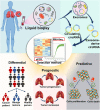Circular RNAs Are Promising Biomarkers in Liquid Biopsy for the Diagnosis of Non-small Cell Lung Cancer
- PMID: 34136531
- PMCID: PMC8201604
- DOI: 10.3389/fmolb.2021.625722
Circular RNAs Are Promising Biomarkers in Liquid Biopsy for the Diagnosis of Non-small Cell Lung Cancer
Abstract
The high incidence and mortality of lung cancer make early detection of lung cancer particularly important. At present, the diagnosis of lung cancer mainly depends on diagnostic imaging and tissue biopsy. However, current diagnostics are not satisfactory owing to the low specificity and inability of multiple sampling. Accumulating evidence indicates that circular RNAs (circRNAs) play a critical role in cancer progression and are promising cancer biomarkers. In particular, circRNAs are considered novel specific diagnostic markers for non-small cell lung cancer (NSCLC). Liquid biopsy is an important method in the early diagnosis of cancer due to its high sensitivity and specificity, as well as the possibility of performing multiple sampling. circRNAs are stably present in exosomes and sometimes become part of circulating nucleic acids, making them ideal for liquid biopsy. In this review, we summarize the advances in the research on circRNAs in NSCLC, and also highlight their potential applications for NSCLC detection.
Keywords: biomarker; circular RNAs; exosome; liquid biopsy; non-small cell lung cancer.
Copyright © 2021 Huang, Rong, Tang, Yi, Wu and Wang.
Conflict of interest statement
The authors declare that the research was conducted in the absence of any commercial or financial relationships that could be construed as a potential conflict of interest.
Figures



References
-
- Bachmayr-Heyda A., Reiner A. T., Auer K., Sukhbaatar N., Aust S., Bachleitner-Hofmann T., et al. (2015). Correlation of circular RNA abundance with proliferation–exemplified with colorectal and ovarian cancer, idiopathic lung fibrosis, and normal human tissues. Sci. Rep. 5:8057. 10.1038/srep08057 - DOI - PMC - PubMed
Publication types
LinkOut - more resources
Full Text Sources

